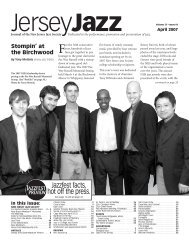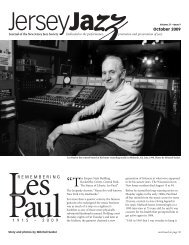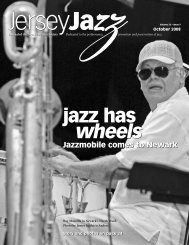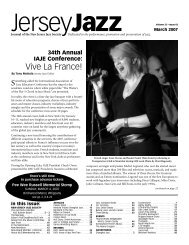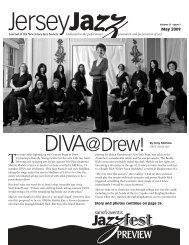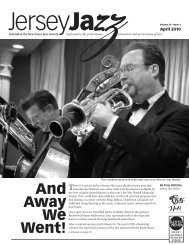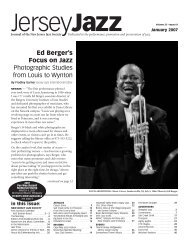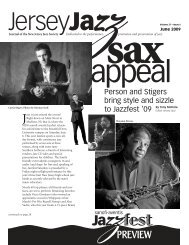Like John Coltrane, James L. Dean got some of his first experience
Like John Coltrane, James L. Dean got some of his first experience
Like John Coltrane, James L. Dean got some of his first experience
Create successful ePaper yourself
Turn your PDF publications into a flip-book with our unique Google optimized e-Paper software.
JerseyReviewsJazzBook Review | Playing the Changes:Milt Hinton’s Life in Stories and PhotographsBu Milt Hinton, David G. Berger and Holly MaxsonVanderbilt University Press, Nashville | 364 Pages, Illus., CD included, $75.00By Joe Lang NJJS Music Committee ChairMilt Hinton was primarily known as ajazz bassist, but, as has been shown inthree books, he was also a sensitive andaccomplished photographer and raconteur.The latest <strong>of</strong> these volumes, Playing theChanges, is a treasure trove for jazz fans.The story <strong>of</strong> Milt Hinton’s life is one <strong>of</strong> aman who rose from extremely humblebeginnings to a place at the top <strong>of</strong> <strong>his</strong> chosenfield. Along the way, he <strong>experience</strong>d manytrying times, saw <strong>first</strong>-hand the scourge <strong>of</strong>racism, took advantage <strong>of</strong> the strong valuesimplanted in him by <strong>his</strong> family, particularly<strong>his</strong> maternal grandmother, and used <strong>his</strong>courage, intelligence, sensitivity and talentto succeed in the many areas <strong>of</strong> <strong>his</strong> life.His story starts in Vicksburg, Mississippi onJune 23, 1910. His father was gone from thefamily by the time Hinton was three monthsold. He lived with <strong>his</strong> mother and her twosisters, but was primarily raised by <strong>his</strong>“Mama,” <strong>his</strong> maternal grandmother, thewoman who kept the family together. Hehad no meaningful contact with <strong>his</strong> fatheruntil he was playing a gig in Memp<strong>his</strong> withCab Calloway in 1940, and <strong>his</strong> father showedup to hear him. Hinton relates many talesfrom <strong>his</strong> childhood in Mississippi, includingthe harrowing <strong>experience</strong> <strong>of</strong> witnessing<strong>first</strong>-hand the lynching <strong>of</strong> a black man.Eventually, the family migrated to Chicago,following the lead <strong>of</strong> Hinton’s two uncles,Bob and Matt. It was in Chicago that he <strong>first</strong>became involved in music. He started onviolin at the age <strong>of</strong> 13, but switched to basswhile at Wendell Phillips High School, aschool with an outstanding music program.Hinton’s instrument switch was influencedby the onset <strong>of</strong> talking movies, when heobserved that the demand for violinists suddenlysubsided as the need for live musiciansto play along with silent movies receded.Hinton became involved in all aspects <strong>of</strong> themusic program at Wendell Phillips, and wasselected to play bass in the Chicago All CityOrchestra. Following graduation, Hintonattended Crane JuniorCollege, and then, for abrief time, NorthwesternUniversity.Quite fascinating are <strong>his</strong>stories <strong>of</strong> <strong>his</strong> non-musical lifein Chicago. His Uncle Mattwas involved with many shadypeople, and at one point <strong>got</strong>Milt a job working for a bootleggerinvolved with AlCapone. The interlude in thebook devoted to t<strong>his</strong> shortphase <strong>of</strong> Hinton’s life is aterrific read. T<strong>his</strong> is but one<strong>of</strong> several stories foundthroughout that are notdirectly related to music, butare welcome additions to thelife story that Hinton relates.Playing music, however, wasHinton’s primary focus in life.He started playing pr<strong>of</strong>essionallywhile still in highschool, and it did not takehim very long at Northwesternto realize that music was <strong>his</strong> true calling. Heunderstood that the sooner he devoted himselfcompletely to playing music, the betterchance he had to develop pr<strong>of</strong>essionally. Heplayed with several bands around Chicago,most notably in that <strong>of</strong> Erskine Tate. His bigbreak came with the opportunity to join thegroup <strong>of</strong> the renowned jazz violinist EddieSouth, with whom Hinton toured extensivelyuntil the demand for South and <strong>his</strong> groupwaned. Hinton stayed around Chicago until,in 1936, he was recommended to fill thevacant bass position in the Cab Callowayband by trombonist Keg <strong>John</strong>son, who hadplayed in a band in Chicago with Hinton.T<strong>his</strong> began an association that lasted untilthe early 1950s when Cab’s star dimmed,and Hinton had to find other sources <strong>of</strong>income. His lengthy stay with Callowayoccupies a significant portion <strong>of</strong> t<strong>his</strong> book.The portraits that Hinton paints <strong>of</strong> themany personalities on the band, the bandstories, and the insight that he <strong>of</strong>fers intothe life <strong>of</strong> a musician on the road are relatedin a style that is articulate, engaging, amusingand informative. There are larger than lifedepictions <strong>of</strong> players like “Chu” Berry, BenWebster, “Dizzy” Gillespie, and, <strong>of</strong> course,Cab. The famous “spitball” story is related indetail. There are several incidents demonstratingthe tribulations that the bandendured due to racism.Following, <strong>his</strong> stay with Calloway, Hintonmade New York City <strong>his</strong> home base andfound <strong>his</strong> way into the world <strong>of</strong> freelancestudio work. Playing for radio and televisionshows, commercial jingle sessions, jazz andpopular recordings, and an occasional livejazz gig dominated Hinton’s pr<strong>of</strong>essional lifeuntil the late 1960s, when there was a fall<strong>of</strong>fcontinued on page 45May 2008___________________________________ 43



